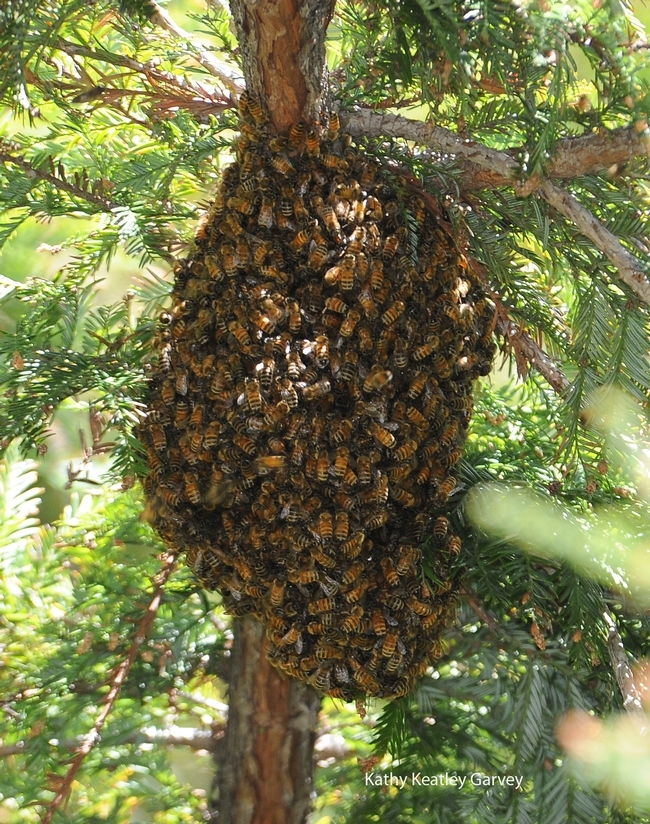Africanized honey bees arrived in southern California in 1994 and are expanding north. How far north are they now?
That's the question being asked all over Central and Northern California, especially since "The Concord Incident" or what happened along Hitchcock Road, Concord last Friday and Saturday. Apparently a backyard beekeeper was trying to move two hives on Friday to allow his father to do some landscaping. The beekeeper reportedly moved the first hive successfully, but when he tried to move the second hive, the bees became highly defensive and wreaked havoc. They killed two dogs, attacked a mail carrier, and stung a number of passersby.
Were they Africanized bees? DNA tests will determine that.
Meanwhile, what is the northern boundary for Africanized bees?
Extension apiculturist (emeritus) Eric Mussen, who retired in June 2014 after 38 years of service, explained it this way:
"The northern boundary of AHBs depends upon the criteria you use to analyze an individual:
1. Mitochondrial DNA: Used by California Department of Food and Agriculture (CDFA) to call them Africanized
2. Morphometrics: Measure quite a number of anatomical features and compare them to features of EHBs and AHBs. Hybrids are hard to categorize, thus not used by CDFA, but the USDA likes it (they "invented" it)
3. Isozymes: Enzymes from AHBs and EHBs have different amino acid arrangements
There are "pockets of bees having one or two of the three criteria, but bees with all three criteria haven't been demonstrated more than about half way up the state from the southern end," Musssen said. Africanized honeybees or AHBs from San Diego, etc., have all three criteria."
And the farthest north they've been found? "If I remember correctly, Angels Camp (Calaveras County) vicinity was farthest north find of samples with all three criteria positive," Mussen related. "Samples around the Concord area had two criteria (up to now). Two samples from very southern Oregon had one criterion."
UC San Diego scientists reported in a press release issued Sept. 11, 2015 that "Africanized bees continue to spread in California."
The study, published that week in the journal PLOS One, "found that more than 60 percent of the foraging honey bees in San Diego County are Africanized and that Africanized bees can now be found as far north as California's delta region," wrote news communicator Kim McDonald.
Said biologist Joshua Kohn, a biology professor who headed the study: "“Our study shows that the large majority of bees one encounters in San Diego County are Africanized and that most of the bees you encounter are from feral colonies, not managed hives,” said Joshua Kohn, a professor of biology at UC San Diego who headed the study."
McDonald explained that "Africanized bees are hybrids of a subspecies from southern Africa that were brought to Brazil to improve bee breeding stock and honey production, but escaped and spread throughout South America and Central America, arriving in Mexico in 1985 and Texas in 1990. Their aggressive behavior and tendency to swarm victims have led them to be dubbed 'killer bees.'"
Kohn and his graduate student Yoshiaki Kono "found Africanized genetic traits in honey bees as far north as 40 kilometers south of Sacramento in the state's central valley," McDonald wrote. "In the bees they collected in San Diego, they also discovered that more than 60 percent of foraging honey bee workers have Africanized genetic traits, but that African traits are found in only 13 percent of managed or commercial hives."
The scientists said the Africanized bees' northward expansion has slowed considerable, and that these bees have a limited ability to survive cold temperatures. In other words, they cannot survive cold winters. However, their presence may "improve the genetic stock of honey bees used in agriculture," according to Kohn.
At UC Davis, assistant professor Brian Johnson of the Department of Entomology and Nematology, is doing research on genetic dispersion of AHBs around the state. He has collected and frozen a large number of feral bee samples from around the south and central portions of the state.
After what happened last weekend, interest in AHB expansion has definitely accelerated. Stay tuned.
Attached Images:

Collection of Africanized bee swarms can be an issue. These bees are European honey bees (not Africanized) that swarmed on the UC Davis North Hall/Dutton Hall complex in 2012. (Photo by Kathy Keatley Garvey)

Scientists are studying feral colonies for Africanized bee expansion. This photo was taken in 2011 in a Vacaville backyard; the European honey bee colony was a joy to the homeowner until its collapse. (Photo by Kathy Keatley Garvey)